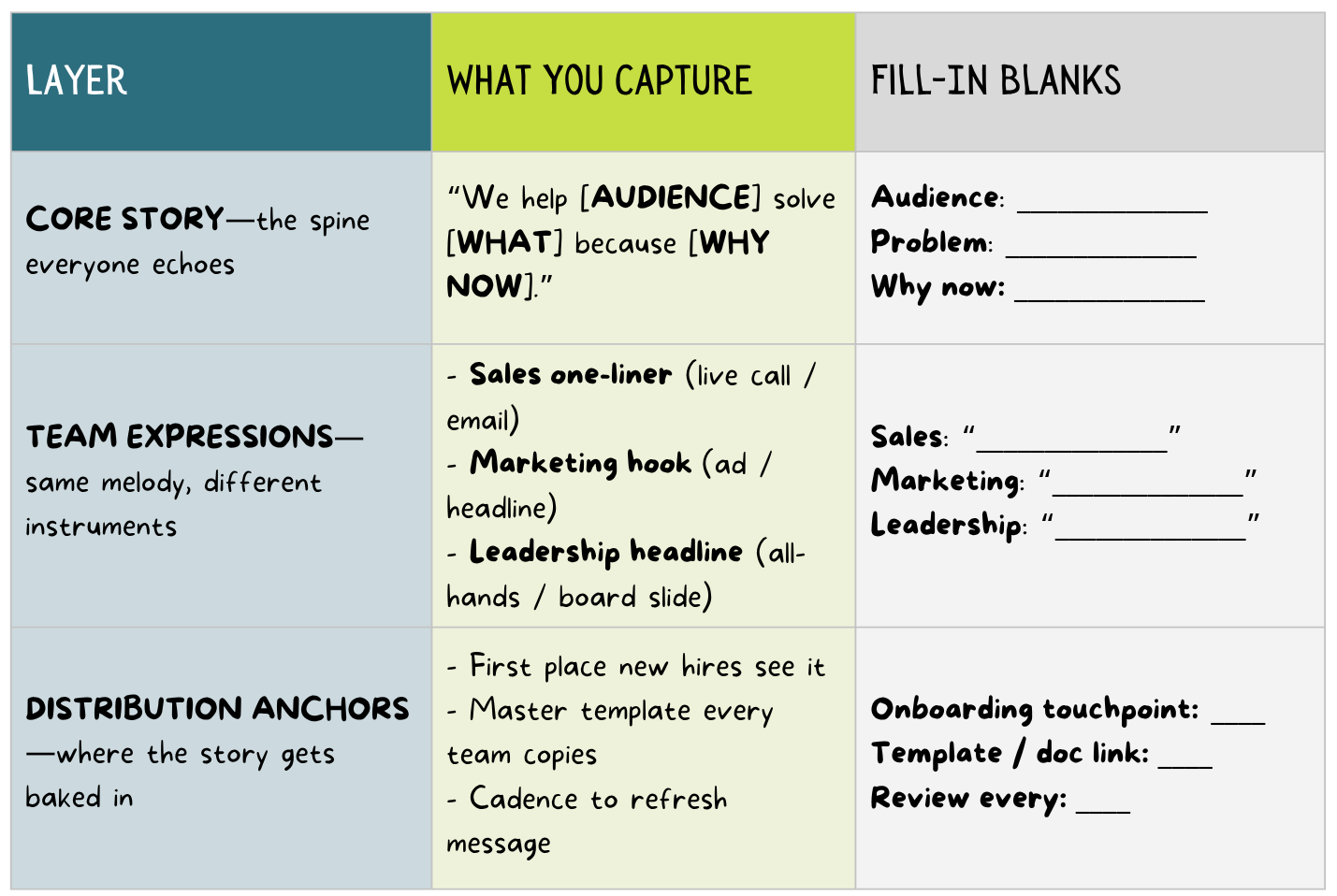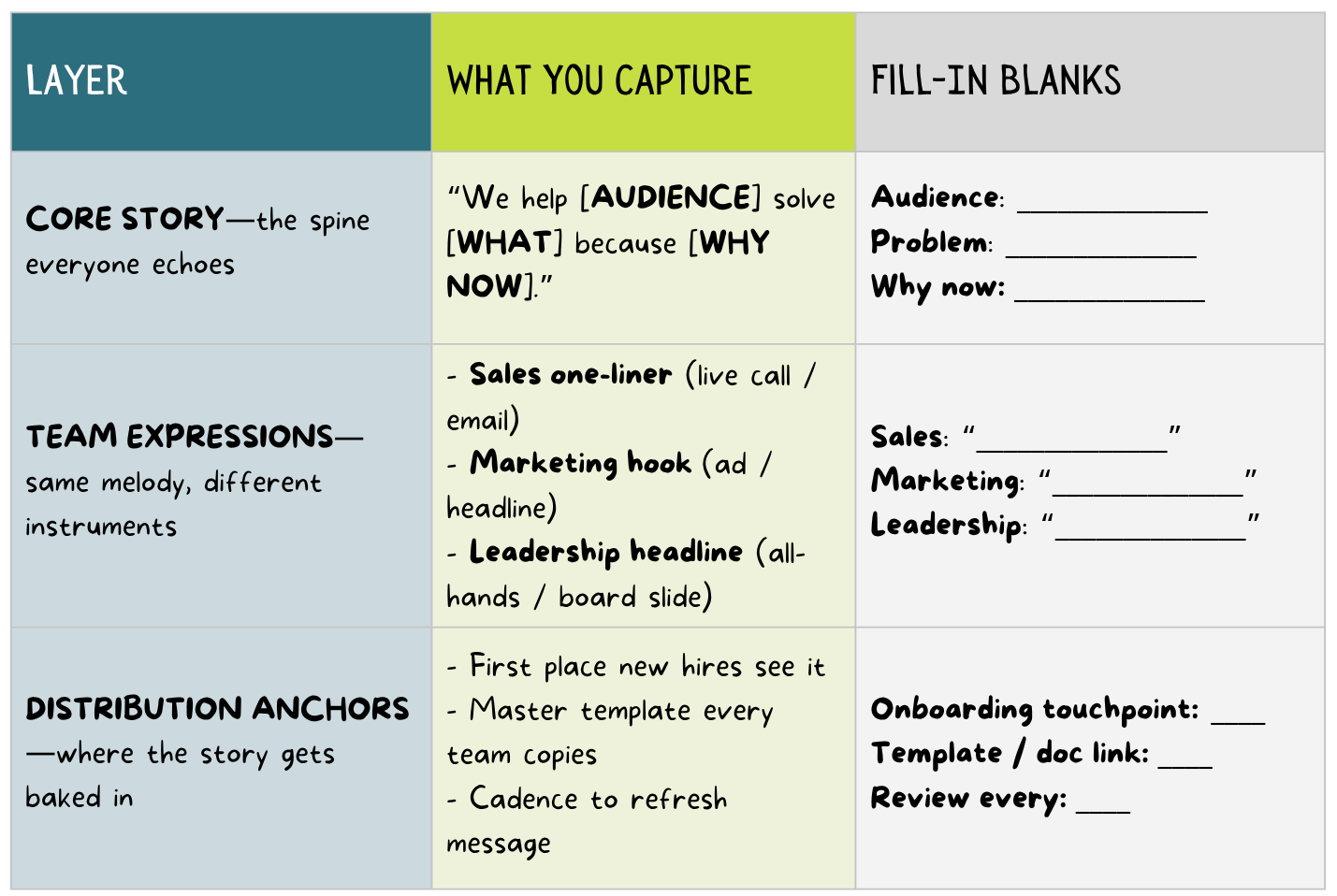There are two kinds of messaging chaos: loud chaos and quiet chaos.
The loud kind is obvious—missed deadlines, wrong logos, rogue slides with fonts that haunt your dreams.
The quiet kind?
That’s trickier.
That's when everyone's doing their job… but they're all telling slightly different stories.
Like when your product team positions your platform as an 'enterprise workflow automation solution,' while sales calls it a 'digital transformation accelerator,' and marketing promotes it as a 'productivity multiplier.'
Same product, three interpretations that confuse your buyers.
Leadership? They’ve got their own version, too.
Individually, none of it is necessarily “wrong.”
But collectively? It’s a slow drift into confusion—internally and externally.
That slight misalignment…..
It adds up.
It pushes your operation in different directions.
It confuses buyers.
It fragments trust.
Sooner or later, it makes your message feel like it’s coming from separate orgs trying to describe the same blurry object.
And misalignment isn't just inconvenient, it’s expensive.
According to IDC (via HubSpot), misalignment between sales and marketing teams costs B2B firms 10% or more of annual revenue. (So yeah. It matters.)
Alignment isn’t about writing one script and forcing everyone to recite it.
It’s about building a shared narrative system (we call it a playbook) that gives each team a way to adapt the message, without changing the meaning.
How to Align Messaging Across Product, Marketing, Sales and Leadership
Messaging misalignment is one of the most common—and costly—breakdowns in growing organizations.
You need a message that’s consistent at the core but flexible enough to work in the real world.
Here’s how to make sure your teams are all telling the same story (without stepping on each other’s toes):
➊ STORY: Align on What You’re Really Selling
If you can’t agree on the top-level story, nothing else matters.
This isn’t your tagline. It’s your core narrative—the strategic spine that answers:
→ What problem are we solving? For whom?
→ Why now?
→ And what makes our approach the obvious choice?
When this story is clear, everyone can build from it. When it’s not, teams end up spinning their own versions, and things unravel fast.
Try this:
"Most [industry] companies [do X]. We [do Y]. We help [who] solve [what], because [why it matters now]."
For example:
"Most enterprise SaaS companies sell you a product that promises to "digitize" or "automate" but leaves you with more questions than answers. We build intuitive platforms with embedded guidance. We help mid-market operations teams solve workflow bottlenecks, because every minute saved in execution compounds into competitive advantage."
➋ EXPRESSION: Translate the Story by Team and Context
Once the core story is locked, each team needs a version that works in their
world- but still ladders up to the same strategic story.
This is what we call expression-level alignment.
Same narrative. Different packaging.
Example:
Core: “We help B2B companies streamline onboarding and reduce ramp time, because faster-ready reps mean faster revenue.”
➤ Sales says it like this: ‘We reduce onboarding time by 50% so your reps can start selling faster.’
➤ Marketing says it like this: ‘Onboard faster. Close sooner.’
➤ Leadership says it like this: ‘We're eliminating onboarding friction to accelerate time-to-revenue across the B2B sales cycle.’
Each team stays true to the core, just expressed in their language, for their use case.
Try it:
Core message: “We help [who] solve [what], because [why it matters now].”
Now translate it across teams:
➤ Sales: “______________________”
➤ Marketing: “___________________”
➤ Leadership:“__________________”
➌ DISTRIBUTION: Operationalize It So It Sticks
To make alignment real, every team needs access to the message and a way to apply it in their own work—without making it up as they go. It’s simple to understand. Harder to operationalize. But infinitely easier than fixing the mess after it spirals.
This is distribution-level alignment.
It’s how you equip people to carry the message forward, consistently and confidently.
That starts by focusing on:
✔ Giving teams language they can use (and adapt)
✔ Making it easy to find, reference, and share
✔ Using simple tools—a 1-pager, a playbook, a shared doc—to keep everyone on the same page
✨ This is where having a messaging playbook makes everything easier - because it gives your team one go-to source for what to say and how to say it.
If you don’t have one yet, start here:
- Write a core message using the template from Step 1
- Share it across teams
- Ask: “How would you say this in your own words?”
- Compare the results: Do they ladder up to the same story? Or are you hearing 3 different companies?
🎯 Action Step: Message-Alignment Organizer
This chart is your sanity-saving cheat sheet.
It breaks alignment into three critical layers:
Story → Expression → Distribution.
Each one builds on the next to ensure your messaging isn’t just written once and forgotten.
(Copy this chart into Notion, Google Sheets, or a whiteboard and fill it out as a team.)

🤖 Bonus GPT Prompt: Quick Alignment Check
Not sure if your teams are telling the same story?
Use this to test whether your message is aligned across teams, or just loosely orbiting the same idea.
Prompt:
I’m giving you three short excerpts that came from our company:
• a sales email
• a marketing post
• a note from leadership
Tasks (answer in bullets):
- In one sentence each, say what story you think Sales, Marketing, and Leadership are telling.
- List the two biggest differences you notice between the three versions.
- Identify the single core idea they all almost share.
- Point out one detail that’s missing or unclear in every version.
- Suggest one small wording change that would make all three feel like they came from the same company.
Here are the excerpts:
–---------------------
[PASTE SALES EMAIL]
–---------------------
[PASTE MARKETING COPY]
–---------------------
[PASTE LEADERSHIP NOTE]
🔄 One last step before you're done.
What’s one place your message shows up today…that probably doesn’t match the others?
Website? Sales deck? Onboarding doc?
That’s your quiet chaos clue.
Want to know more about what a messaging playbook is (and isn’t)? Watch this video.




















